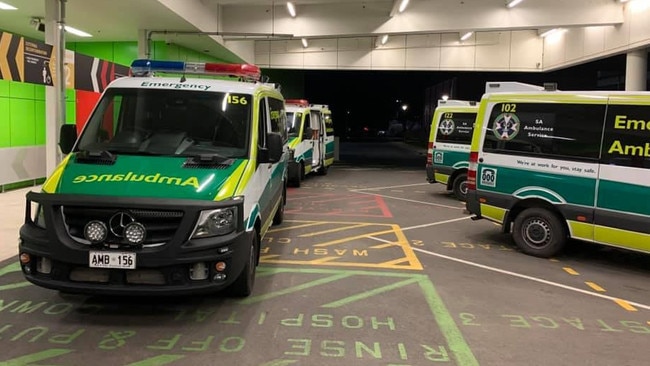Meth ‘explosion’ fuels rise in ambulance ramping at SA hospitals including RAH, Lyell McEwin
A surge in violent meth-affected people having psychotic episodes is clogging hospital EDs, in turn causing ambulance ramping, a parliamentary committee has heard.
SA News
Don't miss out on the headlines from SA News. Followed categories will be added to My News.
An “explosion” in violent meth-affected patients arriving at hospital emergency departments is a key factor behind the surge in ambulance ramping, a parliamentary committee has heard.
Senior Australian Medical Association officials appeared before the Legislative Review Committee inquiry into resourcing of the SA Ambulance Service.
Emergency physician at the Lyell McEwin Hospital, Dr Mohines Pala, told the committee the rising impact of meth addiction was a problem for EDs already dealing with more people due to population growth and an ageing demographic.
“There has been an explosion in methamphetamine-driven psychosis, and it takes a huge amount of resources,” he said.
Dr Pala described a typical situation seen across metropolitan and also regional EDs, where three or four police officers bring in a highly agitated meth-affected person who needs to be sedated.
“It is very resource intensive,” he said. “It is frightening for families to hear the shouting and aggression.”

Dr Pala said multiple staff may be needed to sedate such a patient, and they may have to use resuscitation rooms in order to isolate the violent patient from others.
The patient then needs to be observed for up to six hours before actual treatment, and may end up staying in the emergency department for 24 hours or more.
This in turn takes up limited bed space as well as staff time, adding to ramping.
Dr Pala also revealed why the Lyell McEwin Hospital had much less ramping compared to the Royal Adelaide Hospital – patients are transferred out of ambulances but are then left in corridors, sometimes for hours.
“It’s internal ramping,” he told the committee.
Asked why similar unloading is not done at the RAH, he blamed the design of the $2.4bn hospital for making it difficult, resulting in ambulances stuck in car parks with patients.
AMA state president Michelle Atchison told the committee an urgent overhaul of patient flow processes as “absolutely vital to improve transition of patient care in and out of hospitals.”

“Vast amounts of money are being spent on implementing and advertising ineffective measures while during the same period, ramping has escalated,” she said.
“Ramping is a problem because our hospitals don’t work properly.
“Community care and services are inadequately funded and resourced to care for elderly patients and NDIS patients and mental health patients so they don’t require admission to hospital, where they occupy beds that should be available for people with acute and chronic medical conditions.
“Aged care patients and NDIS patients occupy beds because there are no other places for them to go – there aren’t enough places in aged care facilities and there isn’t the nursing staff within aged care facilities to appropriately care for patients with severe behavioural disturbance.”
Dr Atchison said as well as putting the public at risk, ramping was leaving vulnerable elderly patients in desperate pain and needing the toilet while stuck in ambulances, and causing increased agitation in mental health patients.
More Coverage
Originally published as Meth ‘explosion’ fuels rise in ambulance ramping at SA hospitals including RAH, Lyell McEwin




